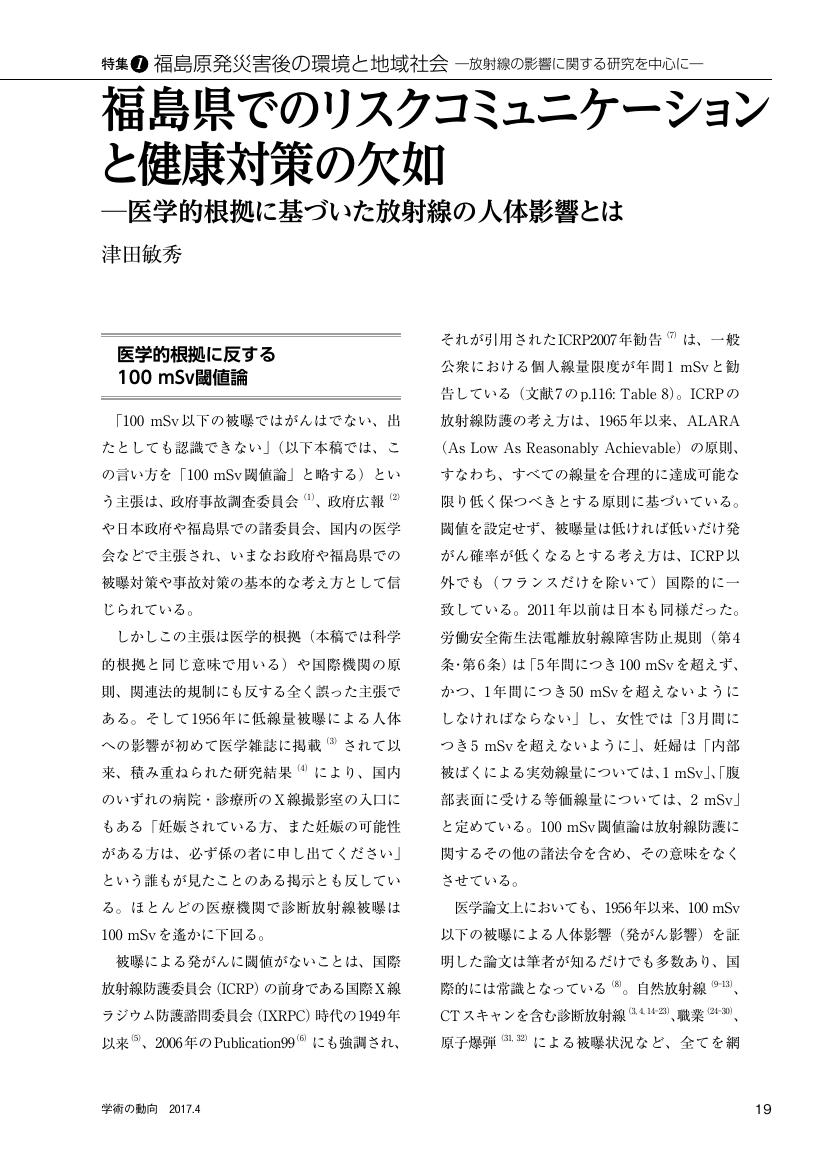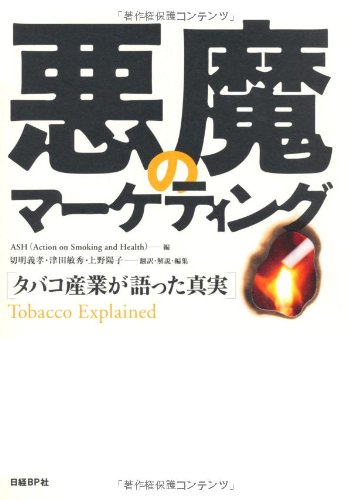191 0 0 0 OA 福島県でのリスクコミュニケーションと健康対策の欠如
- 著者
- 津田 敏秀
- 出版者
- 公益財団法人 日本学術協力財団
- 雑誌
- 学術の動向 (ISSN:13423363)
- 巻号頁・発行日
- vol.22, no.4, pp.4_19-4_27, 2017-04-01 (Released:2017-08-11)
- 参考文献数
- 87
61 0 0 0 OA 医学における因果推論 第一部 ―研究と実践での議論を明瞭にするための反事実モデル―
- 著者
- 鈴木 越治 小松 裕和 頼藤 貴志 山本 英二 土居 弘幸 津田 敏秀
- 出版者
- 一般社団法人日本衛生学会
- 雑誌
- 日本衛生学雑誌 (ISSN:00215082)
- 巻号頁・発行日
- vol.64, no.4, pp.786-795, 2009 (Released:2009-10-02)
- 参考文献数
- 53
- 被引用文献数
- 2 1
A central problem in natural science is identifying general laws of cause and effect. Medical science is devoted to revealing causal relationships in humans. The framework for causal inference applied in epidemiology can contribute substantially to clearly specifying and testing causal hypotheses in many other areas of biomedical research. In this article, we review the importance of defining explicit research hypotheses to make valid causal inferences in medical studies. In the counterfactual model, a causal effect is defined as the contrast between an observed outcome and an outcome that would have been observed in a situation that did not actually happen. The fundamental problem of causal inference should be clear; individual causal effects are not directly observable, and we need to find general causal relationships, using population data. Under an “ideal” randomized trial, the assumption of exchangeability between the exposed and the unexposed groups is met; consequently, population-level causal effects can be estimated. In observational studies, however, there is a greater risk that the assumption of conditional exchangeability may be violated. In summary, in this article, we highlight the following points: (1) individual causal effects cannot be inferred because counterfactual outcomes cannot, by definition, be observed; (2) the distinction between concepts of association and concepts of causation and the basis for the definition of confounding; (3) the importance of elaborating specific research hypotheses in order to evaluate the assumption of conditional exchangeability between the exposed and unexposed groups; (4) the advantages of defining research hypotheses at the population level, including specification of a hypothetical intervention, consistent with the counterfactual model. In addition, we show how understanding the counterfactual model can lay the foundation for correct interpretation of epidemiologic evidence.
- 著者
- 鈴木 越治 小松 裕和 頼藤 貴志 山本 英二 土居 弘幸 津田 敏秀
- 出版者
- 一般社団法人日本衛生学会
- 雑誌
- 日本衛生学雑誌 (ISSN:00215082)
- 巻号頁・発行日
- vol.64, no.4, pp.796-805, 2009 (Released:2009-10-02)
- 参考文献数
- 56
- 被引用文献数
- 3 3
Confounding is frequently a primary concern in epidemiological studies. With the increasing complexity of hypothesized relationships among exposures, outcomes, and covariates, it becomes very difficult to present these hypotheses lucidly and comprehensively. Graphical models are of great benefit in this regard. In this article, we focuse on directed acyclic graphs (DAGs), and review their value for confounder selection, categorization of potential biases, and hypothesis specification. We also discuss the importance of considering causal structures before selecting the covariates to be included in a statistical model and the potential biases introduced by inappropriately adjusting statistical models for covariates. DAGs are nonparametric and qualitative tools for visualizing research hypotheses regarding an exposure, an outcome, and covariates. Causal structures represented in DAGs will rarely be perfectly “correct” owing to the uncertainty about the underlying causal relationships. Nevertheless, to the extent that using DAGs forces greater clarity about causal assumptions, we are able to consider key sources of bias and uncertainty when interpreting study results. In summary, in this article, we review the following three points. (1) Although researchers have not adopted a consistent definition of confounders, using DAGs and the rules of d-separation we are able to identify clearly which variables we must condition on or adjust for in order to test a causal hypothesis under a set of causal assumptions. (2) We also show that DAGs should accurately correspond to research hypotheses of interest. To obtain a valid causal interpretation, research hypotheses should be defined explicitly from the perspective of a counterfactual model before drawing DAGs. A proper interpretation of the coefficients of a statistical model for addressing a specific research hypothesis relies on an accurate specification of a causal DAG reflecting the underlying causal structure. Unless DAGs correspond to research hypotheses, we cannot reliably reach proper conclusions testing the research hypotheses. Finally, (3) we have briefly reviewed other approaches to causal inference, and illustrate how these models are connected.
14 0 0 0 IR 水俣病 : 民主主義と正義のための挑戦 (足立明先生追悼号)
- 著者
- 頼藤 貴志 津田 敏秀 原田 正純
- 出版者
- 熊本学園大学水俣学研究センター
- 雑誌
- 水俣学研究 (ISSN:18840124)
- 巻号頁・発行日
- no.6, pp.103-138, 2015-03
13 0 0 0 OA 医学における因果関係の推論
- 著者
- 津田 敏秀 馬場園 明 三野 善央 松岡 宏明 山本 英二
- 出版者
- The Japanese Society for Hygiene
- 雑誌
- 日本衛生学雑誌 (ISSN:00215082)
- 巻号頁・発行日
- vol.51, no.2, pp.558-568, 1996-07-15 (Released:2009-02-17)
- 参考文献数
- 73
- 被引用文献数
- 2 2
Changes of causal inference concepts in medicine, especially those having to do with chronic diseases, were reviewed. The review is divided into five sections. First, several articles on the increased academic acceptance of observational research are cited. Second, the definitions of confounder and effect modifier concepts are explained. Third, the debate over the so-called “criteria for causal inference” was discussed. Many articles have pointed out various problems related to the lack of logical bases for standard criteria, however, such criteria continue to be misapplied in Japan. Fourth, the Popperian and verificationist concepts of causal inference are summarized. Lastly, a recent controversy on meta-analysis is explained. Causal inference plays an important role in epidemiologic theory and medicine. However, because this concept has not been well-introduced in Japan, there has been much misuse of the concept, especially when used for conventional criteria.
12 0 0 0 OA カネミ油症事件の現況と人権
- 著者
- 原田 正純 浦崎 貞子 蒲池 近江 荒木 千史 上村 早百合 藤野 糺 下津浦 明 津田 敏秀
- 出版者
- 熊本学園大学社会関係学会
- 雑誌
- 社会関係研究 = The Study of Social Relations (ISSN:13410237)
- 巻号頁・発行日
- vol.11, no.1・2, pp.1-50, 2006-02-27
8 0 0 0 OA 疫学入門-疫学的方法論と因果推論
- 著者
- 津田 敏秀 Toshihide TSUDA
- 出版者
- 総合研究大学院大学教育研究交流センター
- 雑誌
- 科学における社会リテラシー3;総合研究大学院大学湘南レクチャー(2005)講義録
- 巻号頁・発行日
- pp.79-102, 2006-02-28
第Ⅰ部 科学原論 第5章 疫学入門-疫学的方法論と因果推論津田 敏秀[岡山大学大学院環境学研究科教授]
6 0 0 0 医学における因果関係の推論 : 意思決定
- 著者
- 津田 敏秀 馬場園 明 茂見 潤 大津 忠弘 三野 善央
- 出版者
- 公益社団法人 日本産業衛生学会
- 雑誌
- 産業衛生学雑誌 (ISSN:13410725)
- 巻号頁・発行日
- vol.43, no.5, pp.161-173, 2001
- 参考文献数
- 63
- 被引用文献数
- 1 1
医学における因果関係の推論-意思決定-:津田敏秀ほか.岡山大学大学院医歯学総合研究科社会環境生命科学専攻長寿社会医学講座-産業医学においては, 予防施策を講じるにおいても補償問題においても, しばしば業務起因性が問題となる.また近年ではリスクアセスメントにおいても疫学の重要性が増し疫学的因果論を産業現場においても認識する必要が出てきた.我々は, 医学における因果律が確率的因果律として認識される事を明らかにしてきた.この因果律は, 科学のモデルの1つとして見なされてきた物理学においても同様に確率現象として認知されて来た.数学者・物理学者たちは, 因果推論において確率的思考が重要であることを, 不確定性原理が発見される以前に同様に主張してきた.それから, 病因割合, 曝露群寄与危険度割合, 原因確率, 等々で呼ばれる指標を説明した.原因確率(PC)は, ある特定の曝露によって引き起こされた疾病の個々の症例への条件付き確率を知るために用いられてきた.これは, 適当な相対危険度を決定するために曝露集団の経験を使って求められ, 曝露症例への補償のためにしばしば用いられてきた.最近の原因確率に関する議論も本論文の中で示した.次に, 人口集団からの因情報を個別個人の因果情報として適用可能であることを示した.日常生活においてさえ, 我々は因果を考える際に, 多くの人々によって試行された結果に基づいて因果を判断している.その上で, 我々は疫学研究から得られた結果を個人における曝露と疾病の関連に応用することに関して疑う懐疑主義を批判した.第三に, 我々は疫学の手短な歴史的視点を提供した.疫学はいくつかの期間を経て発展してきたが, 日本においては, 近年それぞれの疫学者が学んだ時代に依存して疫学者間で多くの互いに共約不可能な現象を観察することになった.第四に, 疫学的証拠に基づいた判断や政治的応用について, 柳本の分類に基づいて考察した.そして, 判断の理由付けのいくつかの例を呈示した.疫学の分野では因果関係による影響の大きさが確率として認知され, 意志決定にも極めて役に立つ.最後に, 疫学の未来におけるいくつかの課題について考察した.
- 著者
- 津田 敏秀
- 出版者
- 岩波書店
- 雑誌
- 科学 (ISSN:00227625)
- 巻号頁・発行日
- vol.86, no.8, pp.797-805, 2016-08
本研究は、《福島放射能被害・水俣病・アスベスト被害などの潜伏的健康被害と地球温暖化の大規模災害の救済システムの国際的学際研究――21世紀型不法行為に関する医学・法学・工学の対話》がテーマである。敷衍すると、福島原発事故の放射能被害をはじめとする蓄積的健康被害および地球温暖化に関わる大災害の救済システムについて、医学・原子力工学などの自然科学の経験分析研究と、環境法・医事法・居住福祉法学やリスク論の方法論的展開を踏まえた法学研究を糾合しつつ、被災者の社会学的知見や医療人類学的な分析も取り込みながら、従来の損害賠償法のスキームに囚われぬ総合的枠組みを現状批判的に再構築することを目指す。
- 著者
- 津田 敏秀
- 出版者
- 公益財団法人 日本学術協力財団
- 雑誌
- 学術の動向 (ISSN:13423363)
- 巻号頁・発行日
- vol.22, no.4, pp.4_19-4_27, 2017
2 0 0 0 OA 我が国の社会医学における因果関係論の構築を目指して
- 著者
- 津田 敏秀 馬場園 明 三野 善央 山本 英二 宮井 正彌 茂見 潤
- 出版者
- The Japanese Society for Hygiene
- 雑誌
- 日本衛生学雑誌 (ISSN:00215082)
- 巻号頁・発行日
- vol.55, no.2, pp.462-473, 2000-07-15 (Released:2009-02-17)
- 参考文献数
- 49
As a condition to achieving an agreement of recognition on the causal relationship in medicine, we firstly explained Hume's problem and counterfactual model. We, however, emphasized that we believe in the existence of causality on medical issues in our daily lives. Therefore, we illustrated conditions when we usually believe in causality. On the other hand, we criticized two well-known key phrases, “lack of mechanism in epidemiology” and “black box in epidemiology”, which have often been used in Japan for skeptic viewpoints against epidemiologic methods even if epidemiology is often used to elucidate a causal effect in medicine in the world. We emphasized that a priori determinations of levels for inference of mechanism is necessary. And, the level and feature of mechanism should be defined in concrete expressions. After explanation of these basic concepts, we mentioned a classic view on specific diseases and non-specific diseases which have not been sufficiently discussed enough yet in Japan. As an example, we used the statements in the Japanese Compensation Law for the Health Effect by Environmental Pollution. In Japan, the classification of these diseases has been confused with that between manifestational criteria of diseases and causal criteria of them. We described the basic concepts to illustrate the causal relationship between non-specific disease and its exposure by using attached figures. Actually, we cannot recognize disease occurrence as a specific disease for several reasons. We indicated that we can recognize the magnitude of effect by causal relationships in medicine as a quantitative continuous variable.
1 0 0 0 悪魔のマーケティング : タバコ産業が語った真実
- 著者
- ASH編 切明義孝 津田敏秀 上野陽子翻訳・解説・編集
- 出版者
- 日経BP出版センター (発売)
- 巻号頁・発行日
- 2005
1 0 0 0 OA 医学における因果関係の推論 : 意思決定
- 著者
- 津田 敏秀 馬場園 明 茂見 潤 大津 忠弘 三野 善央
- 出版者
- 公益社団法人 日本産業衛生学会
- 雑誌
- 産業衛生学雑誌 (ISSN:13410725)
- 巻号頁・発行日
- vol.43, no.5, pp.161-173, 2001-09-20 (Released:2017-08-04)
- 参考文献数
- 63
- 被引用文献数
- 1 1
医学における因果関係の推論-意思決定-:津田敏秀ほか.岡山大学大学院医歯学総合研究科社会環境生命科学専攻長寿社会医学講座-産業医学においては, 予防施策を講じるにおいても補償問題においても, しばしば業務起因性が問題となる.また近年ではリスクアセスメントにおいても疫学の重要性が増し疫学的因果論を産業現場においても認識する必要が出てきた.我々は, 医学における因果律が確率的因果律として認識される事を明らかにしてきた.この因果律は, 科学のモデルの1つとして見なされてきた物理学においても同様に確率現象として認知されて来た.数学者・物理学者たちは, 因果推論において確率的思考が重要であることを, 不確定性原理が発見される以前に同様に主張してきた.それから, 病因割合, 曝露群寄与危険度割合, 原因確率, 等々で呼ばれる指標を説明した.原因確率(PC)は, ある特定の曝露によって引き起こされた疾病の個々の症例への条件付き確率を知るために用いられてきた.これは, 適当な相対危険度を決定するために曝露集団の経験を使って求められ, 曝露症例への補償のためにしばしば用いられてきた.最近の原因確率に関する議論も本論文の中で示した.次に, 人口集団からの因情報を個別個人の因果情報として適用可能であることを示した.日常生活においてさえ, 我々は因果を考える際に, 多くの人々によって試行された結果に基づいて因果を判断している.その上で, 我々は疫学研究から得られた結果を個人における曝露と疾病の関連に応用することに関して疑う懐疑主義を批判した.第三に, 我々は疫学の手短な歴史的視点を提供した.疫学はいくつかの期間を経て発展してきたが, 日本においては, 近年それぞれの疫学者が学んだ時代に依存して疫学者間で多くの互いに共約不可能な現象を観察することになった.第四に, 疫学的証拠に基づいた判断や政治的応用について, 柳本の分類に基づいて考察した.そして, 判断の理由付けのいくつかの例を呈示した.疫学の分野では因果関係による影響の大きさが確率として認知され, 意志決定にも極めて役に立つ.最後に, 疫学の未来におけるいくつかの課題について考察した.
- 著者
- 津田 敏秀
- 出版者
- 岩波書店
- 雑誌
- 科学 (ISSN:00227625)
- 巻号頁・発行日
- vol.87, no.7, pp.690-695, 2017-07
1 0 0 0 OA 水俣病 : 民主主義と正義のための挑戦 (足立明先生追悼号)
- 著者
- 頼藤 貴志 津田 敏秀 原田 正純
- 出版者
- 熊本学園大学水俣学研究センター
- 雑誌
- 水俣学研究 = Journal of Minamata studies (ISSN:18840124)
- 巻号頁・発行日
- no.6, pp.103-138, 2015-03-31
1 0 0 0 多発と因果関係 : 原発事故と甲状腺がん発生の事例を用いて
- 著者
- 津田 敏秀 山本 英二
- 出版者
- 岩波書店
- 雑誌
- 科学 (ISSN:00227625)
- 巻号頁・発行日
- vol.83, no.5, pp.497-503, 2013-05
- 著者
- 津田 敏秀
- 出版者
- 日本臨床社
- 雑誌
- 日本臨床 (ISSN:00471852)
- 巻号頁・発行日
- vol.70, no.3, pp.497-502, 2012-03
1 0 0 0 保健医療における因果関係の推論--疫学の立場からの科学哲学的考察
1 0 0 0 我が国の社会医学における因果関係論の構築を目指して
- 著者
- 津田 敏秀 馬場 明園 三野 善央 山本 英二 宮井 正弥 茂見 潤
- 出版者
- 日本衛生学会
- 雑誌
- 日本衞生學雜誌 (ISSN:00215082)
- 巻号頁・発行日
- vol.55, no.2, pp.462-473, 2000-07-15
- 被引用文献数
- 1 2
As a condition to achieving an agreement of recognition on the causal relationship in medicine, we firstly explained Hume's problem and counterfactual model. We, however, emphasized that we believe in the existence of causality on medical issues in our daily lives. Therefore, we illustrated conditions when we usually believe in causality. On the other hand, we criticized two well-known key phrases, "lack of mechanism in epidemiology" and "black box in epidemiology", which have often been used in Japan for skeptic viewpoints against epidemiologic methods even if epidemiology is often used to elucidate a causal effect in medicine in the world. We emphasized that a priori determinations of levels for inference of mechanism is necessary. And, the level and feature of mechanism should be defined in concrete expressions. After explanation of these basic concepts, we mentioned a classic view on specific diseases and non-specific diseases which have not been sufficiently discussed enough yet in Japan. As an example, we used the statements in the Japanese Compensation Law for the Health Effect by Environmental Pollution. In Japan, the classification of these diseases has been confused with that between manifestational criteria of diseases and causal criteria of them. We described the basic concepts to illustrate the causal relationship between non-specific disease and its exposure by using attached figures. Actually, we cannot recognize disease occurrence as a specific disease for several reasons. We indicated that we can recognize the magnitude of effect by causal relationships in medicine as a quantitative continuous variable.

